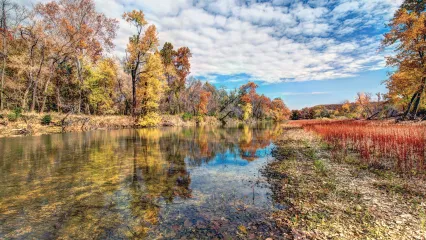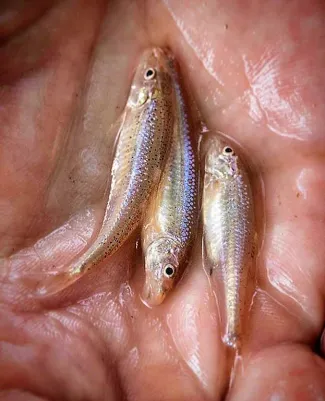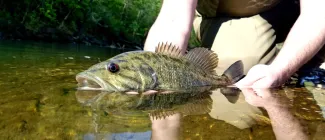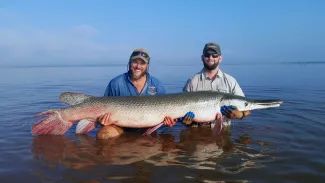
Barren Fork Creek
As Oklahomans, we are blessed to have a diverse landscape complemented by flowing rivers and streams that host a variety of plants and animals. Not only do these streams add to our strong outdoor culture and tradition, but they also provide Oklahomans with clean flowing water that contributes to a robust quality of life.
The conservation of our streams and rivers is a priority at the Oklahoma Department of Wildlife Conservation, and much of our investment in aquatic research is directed toward instream flow, or the amount of water that flows in a river or steam. Maintaining and improving the ecological health of our flowing waters is critical to providing a legacy of sustainable outdoor recreational opportunities for future generations.
In collaboration with many talented in-state university researchers, the Wildlife Department is actively working to conserve and protect our streams and rivers. These partnerships, along with our own internal research efforts at the Oklahoma Fishery Research Laboratory, are providing data and answering key research questions that enable the Department to support scientifically sound management practices that benefit all Oklahomans.
This article highlights some of the ongoing research efforts focusing on our rivers and streams and the species that live there.
Project T-104-R-1: Movement and Flowrecruitment Relationships of Prairie Chub: An Endemic Great Plains Cyprinid.
Project Leader: Shannon Brewer, Oklahoma State University.
The prairie chub is one of 20 species of fish currently listed as a Tier 1 Species of Greatest Conservation Need in Oklahoma. Despite being a conservation priority, very little research has been done that explores how the amount of flowing water in its environment affects this fish.
With increasing tension over water allocation and the threat of more droughts in the Great Plains, it is imperative to understand how prairie chubs use water flow and how changing flow patterns affect their survival. This study aims to understand just that while also estimating the current population of prairie chubs in the upper Red River.
Ultimately, this study will help the Wildlife Department understand the flow needs of this species and provide sound data for future stream flow management practices. To date, project investigators have tagged 933 prairie chubs and are tracking their movements.

Project T-100-R-1: Targeted Surveys for the Peppered Shiner in the Kiamichi, Little, Glover and Mountain Fork Rivers.
Project Leader: Daniel Allen, University of Oklahoma.
The peppered shiner is a rare species only found in a few rivers in the south-central United States. To better conserve this species, there is a clear need to know where and how many peppered shiners exist within its Oklahoma range.
This project is working to estimate the distribution and abundance of the peppered shiner in the Kiamichi, Little, Glover and Mountain Fork Rivers by field surveys. Habitat characteristics are also being examined to better understand this sensitive species’ habitat requirements.
Results from this research project will provide the Wildlife Department with updated distribution and population data for peppered shiners in Oklahoma. Following the first season of field sampling at more than 60 stream sites, just one peppered shiner has been collected, reinforcing just how rare these fish are in southeastern Oklahoma.

Project F-106-R-1: Black Bass Angler Harvest and Opinions in Relation to Stream Size, Access, and Fish Diversity.
Project Leader: James Long and Omkar Joshi, Oklahoma State University.
Through extensive creel surveys, this study aims to determine fishing pressure in an area, how many fish are caught, how many fish are harvested, and overall satisfaction of Oklahoma stream anglers. In addition, researchers will be able to better understand eastern Oklahoma stream anglers.
Understanding the quality of a fishery as it relates to angler effort, catch of sport fish, overall catch rates, species variety, and harvest numbers is needed to better manage these resources while also meeting angler demands.
Project results will help the Wildlife Department provide sustainable fishing opportunities for stream anglers, and economic data will allow an estimated value to be placed on Oklahoma stream fisheries, which is important in making stream flow decisions.
Project investigators continue to survey anglers (more than 100 surveyed to date) and collect data from tagged bass being reported by anglers. Tagged bass reports have been low; only three anglers reported harvesting
a tagged bass.
Project F-100-R-1: Effects of Sucker Gigging on Fish Populations in Oklahoma Scenic Rivers.
Project Leader: Daniel Shoup and Shannon Brewer, Oklahoma State University.
Many species of suckers are ecologically and recreationally important despite not being considered sport fish in most states.
Gigging suckers is a popular and culturally significant pastime in the Ozark Highlands. However, the effect gigging has on population dynamics of suckers is not well understood. Therefore, research is needed to determine safe levels of sucker harvest in order to ensure sustainability of sucker gigging while protecting sensitive aquatic systems.
This study focuses on learning more about what habitats are most important for adult fish during the spring spawn, and what habitats are used by young fish. Project investigators will also determine the population size, age structure and total mortality rate for common sucker species.
This information is important for the Wildlife Department to better understand sucker populations of northeastern Oklahoma. Study results will inform a sustainable recreational fishery approach to better managing the ecological health of Ozark streams. Sucker tagging for mark-and-recapture population estimates is ongoing in this river system. Project investigators are spending many hours processing otoliths (bonelike structures of the ear) for estimating ages of the various sucker species collected during gigging tournaments.

Project F-50-R-26: Estimating population and exploitation of Alligator Gar (Atractosteus spatula) in Lake Texoma.
Project Leader: Richard Snow, Oklahoma Fishery Research Laboratory (ODWC).
The alligator gar is among four species of gar in Oklahoma. They are mostly found in Lake Texoma, the upper Red River and its tributaries.
Stream flow is a critical factor in the life cycle of these large fish, as they need enough flowing water to access spawning habitat in the Red River above Lake Texoma. As the number of people who bowfish for alligator gar increases, so does the concern regarding potential effects on the population of this ancient species. But before biologists can identify any potential angling impact, they must first have quality population data that includes population total estimates, age structure and sex ratios.
Currently, more than 250 alligator gars have been tagged in this study. Project investigators have also collected aging structures (otoliths) from 23 of 25 alligator gar reported as harvested by anglers. Additionally, biologists are working to determine the survival rate of alligator gars that are caught and released, and how many alligator gars are harvested by anglers annually. Results of this work will provide much needed data for the Wildlife Department to better manage Oklahoma’s largest, most ancient fish, while providing the most opportunity for anglers.
These research projects highlight the importance of stream flows for fisheries diversity across Oklahoma. From the smallest of fish such as the prairie chub or peppered shiner, all the way up to our largest fish, the alligator gar, the health of the state’s fish populations depends on flowing waters.
Managing and conserving these stream resources provides benefits to Oklahoma anglers and to conservation-minded citizens. Good stewardship of our streams will leave a legacy of conservation that can be enjoyed by future generations of Oklahomans.
(Information and Education Specialist Kelly Adams contributed to this article.)
NOTE: Many conservation research projects are completed each year by the Wildlife Department. For a partial listing of recent projects and final reports from those efforts, go www.wildlifedepartment.com/wildlife/wildlife-diversity/research/swg.
This article was published in the 2020 Jan/Feb issue of the Outdoor Oklahoma magazine. If you would like to be the first to receive this content the be sure to subscribe!